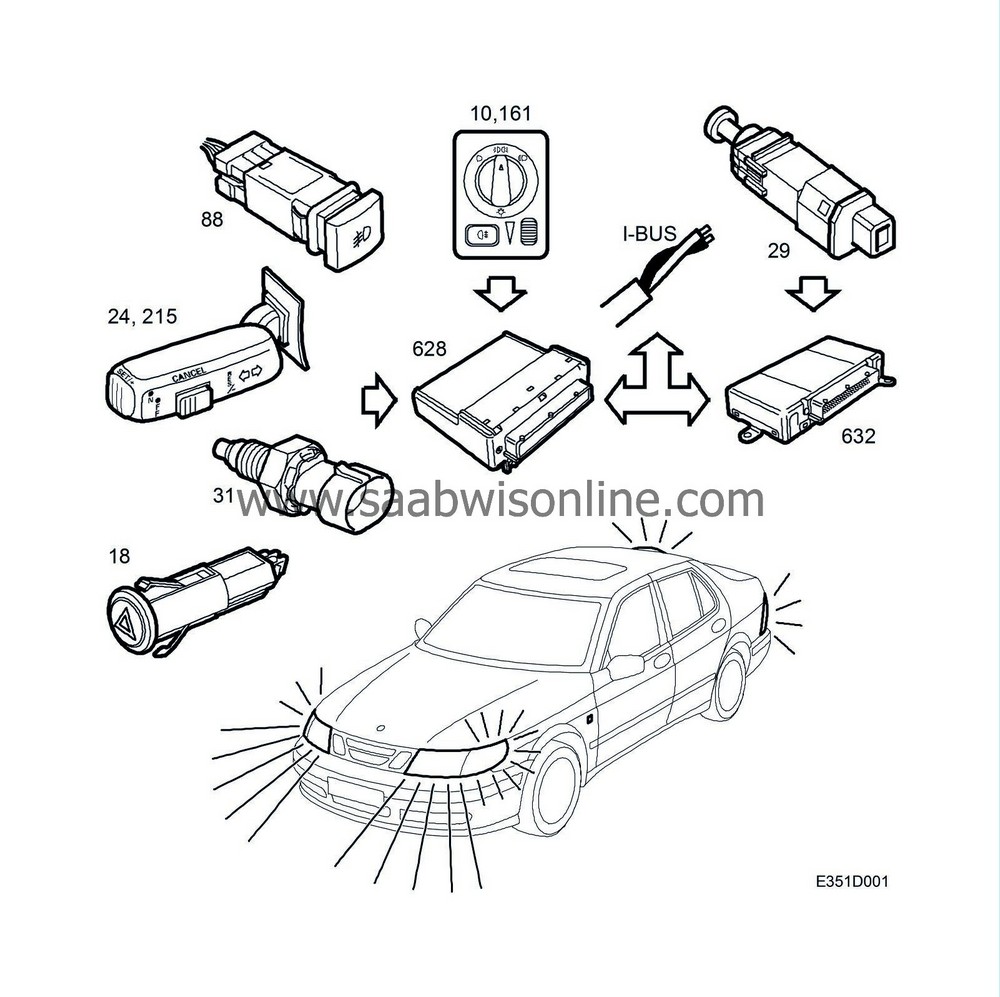PRE-RELEASE
Brief description
| Brief description |
| Exterior lighting |
The car's exterior lighting system is operated with the light switch (on the dashboard) and the dipswitch (on the steering column).
DICE controls the functions on the light switch. There are 3 different program alternatives, depending on the market.
The following functions are included in the car's exterior lighting system:
Headlamps
Main and dipped beams, rear lights, number plate lighting and parking lights are included in the headlamps. The light switch must be in position 2 and the ignition ON to operate the main lighting. The parking lights are monitored by TWICE (like a filament monitor). Main and dipped beams are controlled by DICE via 2 relays.On certain markets, the dipped beam is used as daylight driving lights. The light switch must then be in position 0.
Parking lights
The parking lights are on when the light switch is in position 1 if the ignition is off. Depending on the current program alternative, the parking lights can be on when the light switch is in another position. On certain markets, the dipped beam is used as daylight driving lights.Brake lights
The brake lights go on when the brake pedal is depressed. TWICE monitors the brake light circuit and distributes error messages to the bus.Reversing lights
The reversing lights are turned on by the reversing-light switch when reverse gear is engaged. DICE outputs the status of the reversing-light switch (ON/OFF) to the bus.Front fog lights
2 lamps located in the spoiler. Operated with a switch when the light switch is in position 1 or 2 (depending on market). The function is programmable.Rear fog light
1 lamp located on the right-hand side on right hand drive cars and on the left-hand side on left hand drive cars. Operated with a switch to the right of the light switch.Direction indicators
When activated, DICE sends a message to SID for acoustic indication and to MIU (main instrument unit) for visual indication. The flash frequency is 90 flashes/second.Hazard flashers
Hazard function when all the direction indicators are turned on by the hazard flasher switch.Side reversing lights
On certain markets, lamps located in the front direction indicators light up when reverse gear is engaged. The lamps shine obliquely backward/downward.Side marker lights
On certain markets, a recess in the direction indicator reflector directs light to one side. The direction indicators on these markets have two filaments, of which the thinner is constantly alight.| Interior lighting |
The car's interior lighting comprises the following:
Roof lamps and floor lighting
The roof lamps in the car are turned on and off automatically (doors open/closed), or manually. The interior lighting switch has the following functions:1 - Interior lighting on.
0 - Doors control lighting on/off (Automatic).
2 - Interior lighting off.
DICE, which controls the power supply to the lamps, receives information on the status of the doors via the bus from TWICE.
The following lighting functions are included in the car's interior lighting:
Reading lights
One front spotlight and two rear, located in the roof.Are operated manually with the switch next to each lamp.
Vanity mirror lighting
Lamps in the sun visor next to each vanity mirror. Each lamp turns on and off automatically when the cover over the mirror is opened and closed.Glove box light
Lamp in the glove box. Turns on and off automatically when the glove box is opened and closed.Floor lighting
Lamps in the floor, turn on and off automatically when the respective car door is opened and closed.Courtesy lights
Courtesy lights in the doors. Turn on and off automatically when a car door is opened and closed.Luggage compartment illumination 4D
Light in the luggage compartment. Turns on and off automatically when the lid is opened and closed.Luggage compartment illumination 5D
Light in luggage compartment. Automatically turned on and off when the tailgate is opened or closed respectively. When the tailgate is opened, the lamp shines red to the rear and white downwards.Lighting for buttons and controls
For dimming instrument and control lighting. The light intensity is controlled manually with a potentiometer connected to SID. Information on the potentiometer is output to the bus.| P-bus and I-bus |

All the control modules in the Saab 9-5 are connected to the bus except those for the ABS and SRS.
The bus is divided into a Powertrain bus (P-bus) and an Instrument bus (I-bus). Both buses are connected to the main instrument unit (MIU). The buses have separate electrical systems.
The data transfer rate on the P-bus is ten times faster than on the I-bus.
All the information sent from one control module is accessible for all other control modules on the bus. The MIU is responsible for ensuring that information available on one bus is also available on the other bus.



